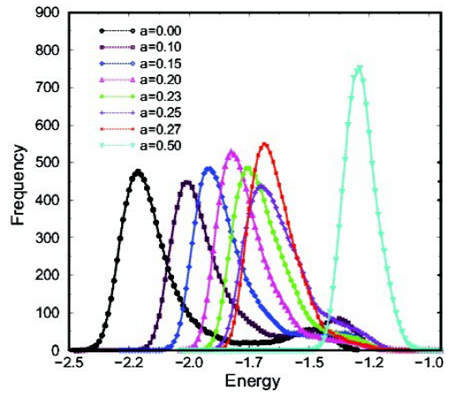
Research Article Volume 2 Issue 4
Cluster size distribution to characterize the first–order phase transitions of equilibrium systems
Lima FWS
Regret for the inconvenience: we are taking measures to prevent fraudulent form submissions by extractors and page crawlers. Please type the correct Captcha word to see email ID.

Department of Physics, Federal University of Piaui, Brazil
Correspondence: Francisco Welington De Sousa Lima, Department of Physics, Dietrich Stauffer Computational Physics Lab, Federal University of Piaui, 64049?550, Teresina?PI, Brazil, Tel 5586 3237 1424
Received: July 30, 2018 | Published: August 17, 2018
Citation: Lima FWS. Cluster size distribution to characterize the first–order phase transitions of equilibrium systems. Phys Astron Int J. 2018;2(4):375-376. DOI: 10.15406/paij.2018.02.00112
Download PDF
Abstract
Through Monte Carlo simulations we study cluster size distribution (CSD) of equilibrium systems. The system is simulated by applying the Wolff algorithm or single cluster Monte Carlo update algorithm. Our results show that CSD is a good tool in the identification of first–order transitions.
Keywords: phase transition, potts model, clusters, wolff
Introduction
Equilibrium systems such as the Potts model with q–states in two–dimension presents two types of phase transition. Continuous or second order and one explosive or first order.1,2 To identify the type of phase transition we have some useful tools such as examining the minimum free energy3,4 by considering the probability distribution of energy,5 the distribution function of the system order parameter PDF,6,7 fourth–order Binder cumulant8,9 and CSD.10–12
In systems that exhibit first–order phase transition the most common feature is the coexistence of ordered and disordered states in the phase transition region. In the region of ordered phase the large clusters are dominant and in the disordered phase, small clusters are dominant. The existence of both small and large clusters in a first–order phase transition region gives rise to double–peak energy behavior and PDFs. Studying the Potts model in two dimensions Aydin et al.,10 and Gündüç et al.,11 observed that global operators related to cluster size are more sensitive to structural changes in a phase transition than energy–related local operators and the order parameter of the system. Notably, the CSD may give a better indication of the order of phase transition for small networks than the distribution of energy.
In this work, we investigate the CSD to study the phase structure of the 8–state Potts model on Voronoi–Delaunay random lattices (VDRL)13 concerning quenched randomness on the links in a range of alpha values a= 0 to 0.5
Model and simulations
We consider the Potts model whit q=8 states on VDRL by a set of spin variables taking the values situated on every site i of a VDRL with N sites. In this random lattice, we start from a two–dimensional random lattice consisting of sites linked to their k (where 3<k<20) and different for each site of network nearest neighbors by both outgoing and incoming links.
The Hamiltonian of the Potts model whit q=8 states can be writen as
(1)
where , T is the temperature ,is the delta of Kronecker ,is the Boltzmann constant, the sum goes over all nearest–neighbors pairs of sites. Here, we assumethat the coupling factor
depends on the relative distance
between sites i and j and is given by
(2)
where is a constant and
a model parameter. In the simulations, we apply the Wolff update algorithm14–17 on differents VDRL to generate different sizes of the cluster and perform simulations comprising a number N= 4000 of sites of random lattices. For each system quenched averages over the connectivity disorder are approximated by averaging over R=100 independent realizations. For each simulation, we have started with a uniform configuration of spins. We ran 3x10⁵ Monte Carlo steps (MCS) per spin with 2X10⁵ configurations discarded to reach steady state.
Results and discussions
From CSD we calculate the average cluster size defined by
(3)
where
and
are the number and sizes of clusters generated by the Wolff algorithm, respectively. In the above equations
stands for thermodynamic averages.
In
Figure 1 we show the histogram of the energy for the values
and for
sites. From
to
we have a double peak structure indicating that a first order phase transition to the Potts model
with states, while for
we have a single Gaussian peak structure that represents an indication for a second order phase transition. To further clarify this behavior we use the mean distribution of clusters as seen in
Figure 2.
As shown in
Figure 2 the peaks in the region of small clusters indicate the presence of first–order transition.

Figure 1 Histogram of the energy for some values of and
sites.

Figure 2 Distribution of the average sizes of clusters to several values of a on a VDRL of sites
and with
.
Conclusion
In summary, the energy histogram is very useful in identifying a first–order phase transition as long as the systems structures are regular as the square lattice, triangular, and other two–dimensional archimedean lattices. In the case here, that is, on VDRL or others random lattices where the Wolff algorithm can be used we have seen that the ASCD is more appropriate for the identification of first–order phase transitions.
Acknowledgements
The author would like to thank the Brazilian agencies CNPq and Capes.
Conflict of interest
The author states that there is no conflict of interest.
References
- Potts RB. Some generalized order–disorder transformations. Proceedings of the Cambridge Philosophical Society. 1952;48(1):106–109.
- Wu FY. The Potts model. Reviews of Modern Physics. 1982;54(1).
- Binder K. Critical Properties from Monte Carlo Coarse Graining and Renormalization. Physical Review Letters. 1981;47(9).
- Binder K. Finite size scaling analysis of ising model block distribution functions. Zeitschrift für Physik B Condensed Matter. 1981;43(2):119–140.
- Binder K, Landau DP. Finite–size scaling at first–order phase transitions. Physical Review B. 1984;30(3).
- Sánchez Alejandro D, Lopes Juan M, Rodriguez Miguel A. Nonequilibrium Phase Transitions in Directed Small–World Networks. Physical Review Letters. 2002;88(4).
- Plascak JA, Martins PHL. Probability distribution function of the order parameter: Mixing fields and universality. Computer Physics Communications. 2013;184(2):259–269.
- Tsai SH, Salinas SR. Fourth–Order Cumulants to Characterize the Phase Transitions of a Spin–1 Ising Model. Brazilian Journal of Physics. 1998;28(1):58–65.
- Lima FWS. Fourth–Order Binder cumulant to characterize the first–order phase transition of equilibrium and nonequilibrium systems. International Journal of Innovations in Engineering and Technology. 2018;10(3):77–79.
- Aydin M, Gündüç Y, Çelik T. Study of cluster fluctuations in the two–dimensional q–state Potts model. Physica A: Statistical Mechanics and its Applications. 1996;230(3–4):651–657.
- Gündüç Y, Çelik T, Aydin M. Cluster distributions in two–dimensional q–state Potts model1. Physica A: Statistical Mechanics and its Applications. 1997;234(3–4):801–806.
- Yasar F, Gündüç Y, Çelik T. Softening of the phase transition in a two–dimensional Potts model under quenched bond randomness. Physical Review E. 1998;58(4).
- Janke W, Katoo M, Villanova R. Single–cluster Monte Carlo study of the Ising model on two–dimensional random lattices. Physical Review B. 1944;49(14).
- Wolff U. Collective Monte Carlo Updating for Spin Systems. Physical Review Letters. 1989;62(4).
- Lima FWS, Moreira JE, Andrade JS, et al. Continuous phase transition in a disordered eight–states Potts model. The European Physical Journal B–Condensed Matter and Complex Systems. 2000;13(1):107–110.
- Lima FWS, Costa UMS, Almeida MP, et al. Critical behavior of a three–state Potts model on a Voronoi lattice. The European Physical Journal B–Condensed Matter and Complex Systems. 2000;17(1):111–114.
- Fernandes FB, Lima FWS, Plascak JA. Blume–Capel model on directed and undirected small–world Voronoi–Delaunay random lattices. Computer Physics Communications. 2010;181(7):1218–1223.

©2018 Lima. This is an open access article distributed under the terms of the,
which
permits unrestricted use, distribution, and build upon your work non-commercially.


